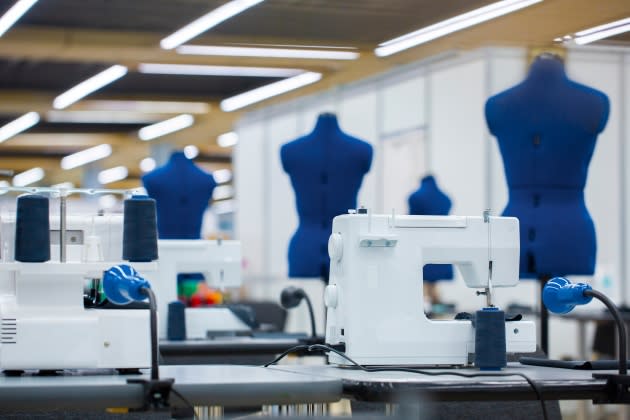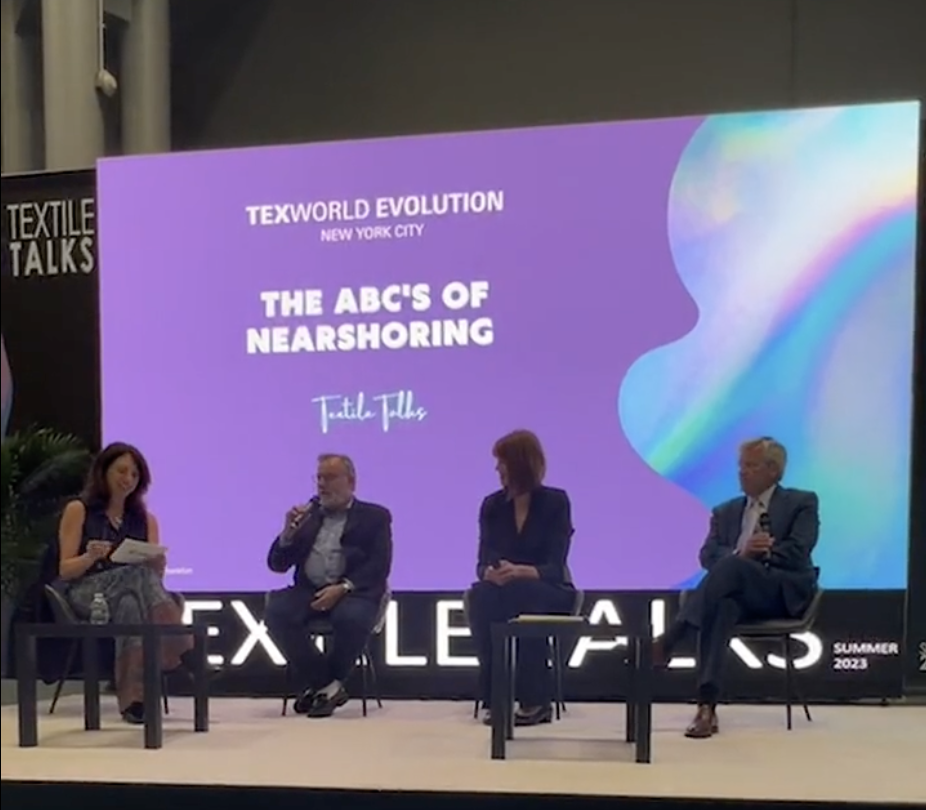Nearshoring: Driving Sustainable Growth

In the marketing material of a Sourcing Journal panel discussion at Texworld Evolution in New York City, the publication’s Lauren Parker, moderator, asked: “When it comes to sourcing apparel, do you know your CAFTA-DR from your USMCA and UFLPA? What about your Section 301 tariffs and Section 321 loopholes? What does the ‘yarn forward’ rule really mean?”
While the participants expertly addressed these questions during the session, titled “The ABC’s of Nearshoring,” they also put a spotlight on what’s driving the growth of nearshoring and other trends. To set the parameters of nearshoring, Parker defined it as apparel manufacturing in Canada, the U.S., Mexico and Central America.
More from WWD
Vintage Expert Byronesque Refines Site, Works Closer With Brands on Resale, Archives
Cercle, a Luxury Rental Platform With a Small and Precise Outlook on Circularity
The speakers were Robert Antoshak, a partner at Gerhzi Textil Organization AG; Kim Glas, president and chief executive officer of the National Council of Textile Organizations (NCTO), and David Smith, executive vice president and president of the textile division at Milliken & Co.
To put the topic into context, Glas said the industry is buzzing about onshoring, or nearshoring, as well as “de-risking the supply chain.”
“Nearshoring is here to stay and it’s going to grow into the future,” Glas explained. “Just in this past year, there’s been $2 billion of new investment both in the United States and in Central America. As brands and retailers continue to look on ways to diversify their supply chains, that’s been significant in yarn, fabric and finished textile and apparel product production. We had companies join the vice president of Unifi and Parkdale to announce their investments both in their U.S. operations and in Central America. We’ve had other companies like San Mar and Gildan make public announcements on their new investments as well.”
Glas said while there was significant growth in 2022, 25 percent year-over-year, apparel and textiles sales have softened. Still, Glas is bullish about the future. “Since NAFTA has been signed in 1993, we’ve seen apparel growth from our Western Hemisphere grow 60 percent,” Glas said. “So, the future is really, really bright and the capabilities of both U.S. manufacturers in the region are enormous and our capacity is there.”
That capacity is triggering a lot of investment as brands and manufacturers seek new opportunities. While Antoshak couldn’t disclose specific deals involving his clients, he said the projects currently in the works “are straight-up reassuring.”
“It’s not just raw material, it’s finished apparel,” Antoshak said. “In Central America, we have expansion operations that are going on right now that we’re involved with, which is basically helping certain companies in the region in Central America to diversify out of just basic knits. They’re doing wovens now, and that’s an interesting project. We do have raw material projects that we’re working on that are basically being created from the ground up in the United States to supply the textile supply chain globally.”
When asked about his perspective about the current market, where it’s been and where it’s headed, Smith said his first thought was that “time flies when you’re having fun. If we think about it, 40 years ago, 97 percent of the clothing worn in this country was made in the USA. Today that’s less than 3 percent. Now that can be attributed to three titanic shifts that occurred. One, which Kim [Glas] has already mentioned, was NAFTA. Secondly was China joining the WTO, and then third was the passage of the CAFTA-DR free trade agreement. Today I’m encouraged and excited about the conversations which are occurring with the brands and the retailers and the bipartisan support of our elected officials to bring manufacturing back in the States.”
Parker then noted that the CAFTA-DR free trade agreement includes the U.S., Honduras, Guatemala, Costa Rica, El Salvador, Nicaragua and the Dominican Republic while the USCMA is the U.S., Mexico and Canada.
Regarding “yarn forward,” Glas explained that if a garment is procured in Guatemala, for example, “our free trade agreement country, the yarn and the fabric and the cutting and sewing needs to happen in the region. The yarn and the fabric could come from the U.S., could come from Honduras, from Guatemala, and then be finished in the region to get the benefit. It is no different than rules of origin for other kinds of products, whether it’s an ag product, whether it’s automobiles, etc. Rules of origin, under our free trade agreements, are intended to drive investment. Brands and retailers want yarn and fabric close by. You don’t want to be waiting from some other country somewhere else in the world.”
But there are other dimensions to the market that transcend free trade agreements: de-risking the supply chain and the demand for greater sustainability — both are addressed by nearshoring.
“COVID-19 created a shift in many people’s minds,” Glas said. “[Executive leaders are saying], ‘I can’t have stranded inventory on one side of the world. I can’t have all my eggs in one basket. I need to be able to manage my inventory. I need to be able to have close proximity.’”
They’re also acknowledging that sustainability is a core value of their company. “All of those things came to a head in sort of this paradigm that we’ve never seen before where people started calling our industry and asking what we can do to help them both in terms of their need in inventory right now and in the future. It became board-level conversations with them saying they want to double what they’re doing in the hemisphere over the next five to 10 years.”
What’s driving these discussions is the realization that brands and manufacturers know that they must do things differently, Glas said.
“Our customers are seeking an agile, resilient and competitive supply chain or value chain,” Smith said. “And this region offers just that, an agile, resilient and competitive alternative. Supply chain disruptions, human rights concerns, growing environmental awareness and consumer preferences are nudging manufacturers and retailers and brands to rethink not only their sourcing decisions but their business model, which creates great opportunity as far as model.”

Smith agreed and said, “Chances are the U.S. and regional textile industry has the capabilities and the capacity to meet your needs. And if there are any gaps, I think you’ll find a listening ear and a willingness to work with you to eliminate those voids. The industry is investing and growing the perception that we have limited yarn capacity or weaving capacity in the region. And when I say in the region, I’m including in the U.S.”
Smith also noted that Milliken has yarn and weaving plants “standing today waiting on that door. There are 700,000 ring spindles that are being installed in Central America as I speak with double the ring spinning capacity in the region and could produce yarn to support 1 billion garments.”
While trade agreements have benefited the textile and apparel industry, there are loopholes that need to be sewn up. Glas cited the “de minimis loophole” as an example. She said it is “essentially an $800 free trade agreement for every country in the world, and we are seeing a superhighway of textile and apparel products utilizing de minimis in this way to importing products.”
Basically, the loophole allows brands and retailers that are in Asia and elsewhere to sell and ship directly to consumers without paying taxes or a tariff if the item or items are under $800. U.S. policymakers estimate that there are 3 million packages that are shipped into the U.S. every day.
Best of WWD


